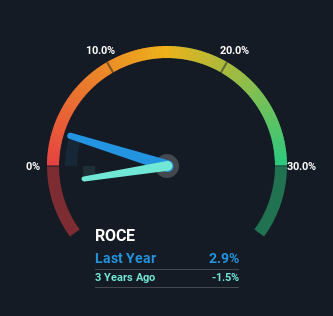What trends should we look for it we want to identify stocks that can multiply in value over the long term? In a perfect world, we'd like to see a company investing more capital into its business and ideally the returns earned from that capital are also increasing. If you see this, it typically means it's a company with a great business model and plenty of profitable reinvestment opportunities. So on that note, Uztel (BVB:UZT) looks quite promising in regards to its trends of return on capital.
Return On Capital Employed (ROCE): What Is It?
For those that aren't sure what ROCE is, it measures the amount of pre-tax profits a company can generate from the capital employed in its business. The formula for this calculation on Uztel is:
Return on Capital Employed = Earnings Before Interest and Tax (EBIT) ÷ (Total Assets - Current Liabilities)
0.029 = RON1.6m ÷ (RON88m - RON34m) (Based on the trailing twelve months to June 2022).
Thus, Uztel has an ROCE of 2.9%. Ultimately, that's a low return and it under-performs the Energy Services industry average of 6.0%.
View our latest analysis for Uztel

Historical performance is a great place to start when researching a stock so above you can see the gauge for Uztel's ROCE against it's prior returns. If you're interested in investigating Uztel's past further, check out this free graph of past earnings, revenue and cash flow.
The Trend Of ROCE
We're delighted to see that Uztel is reaping rewards from its investments and has now broken into profitability. Historically the company was generating losses but as we can see from the latest figures referenced above, they're now earning 2.9% on their capital employed. At first glance, it seems the business is getting more proficient at generating returns, because over the same period, the amount of capital employed has reduced by 32%. The reduction could indicate that the company is selling some assets, and considering returns are up, they appear to be selling the right ones.
For the record though, there was a noticeable increase in the company's current liabilities over the period, so we would attribute some of the ROCE growth to that. Effectively this means that suppliers or short-term creditors are now funding 39% of the business, which is more than it was five years ago. It's worth keeping an eye on this because as the percentage of current liabilities to total assets increases, some aspects of risk also increase.
What We Can Learn From Uztel's ROCE
In a nutshell, we're pleased to see that Uztel has been able to generate higher returns from less capital. Astute investors may have an opportunity here because the stock has declined 14% in the last five years. With that in mind, we believe the promising trends warrant this stock for further investigation.
Uztel does have some risks though, and we've spotted 3 warning signs for Uztel that you might be interested in.
While Uztel may not currently earn the highest returns, we've compiled a list of companies that currently earn more than 25% return on equity. Check out this free list here.
New: AI Stock Screener & Alerts
Our new AI Stock Screener scans the market every day to uncover opportunities.
• Dividend Powerhouses (3%+ Yield)
• Undervalued Small Caps with Insider Buying
• High growth Tech and AI Companies
Or build your own from over 50 metrics.
Have feedback on this article? Concerned about the content? Get in touch with us directly. Alternatively, email editorial-team (at) simplywallst.com.
This article by Simply Wall St is general in nature. We provide commentary based on historical data and analyst forecasts only using an unbiased methodology and our articles are not intended to be financial advice. It does not constitute a recommendation to buy or sell any stock, and does not take account of your objectives, or your financial situation. We aim to bring you long-term focused analysis driven by fundamental data. Note that our analysis may not factor in the latest price-sensitive company announcements or qualitative material. Simply Wall St has no position in any stocks mentioned.
About BVB:UZT
Uztel
Uztel S.A. engages in manufacture and sale of machinery for mining, quarrying, and construction in Romania and internationally.
Mediocre balance sheet and slightly overvalued.
Market Insights
Community Narratives



